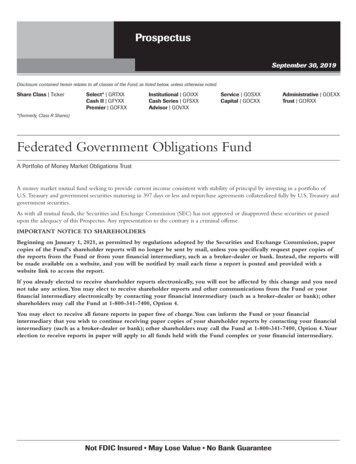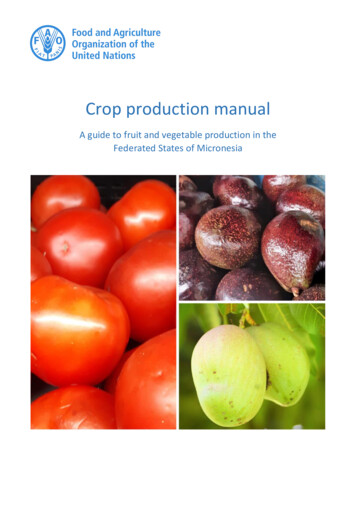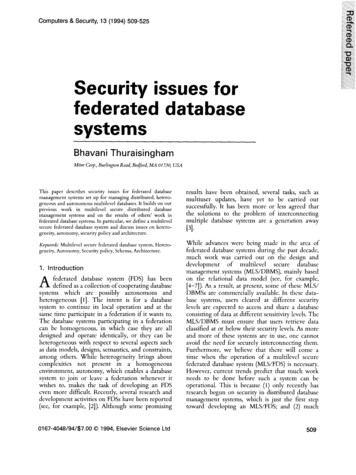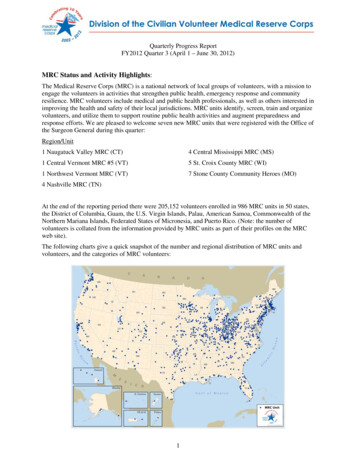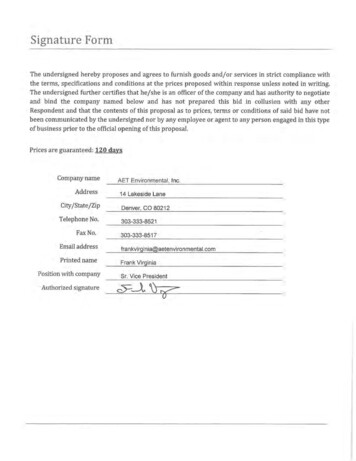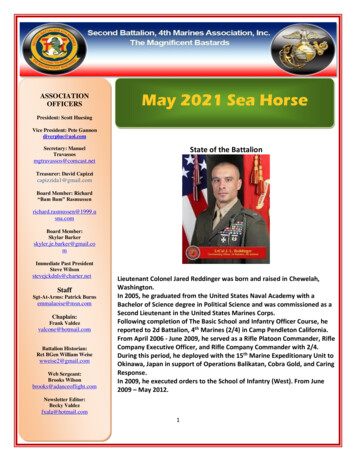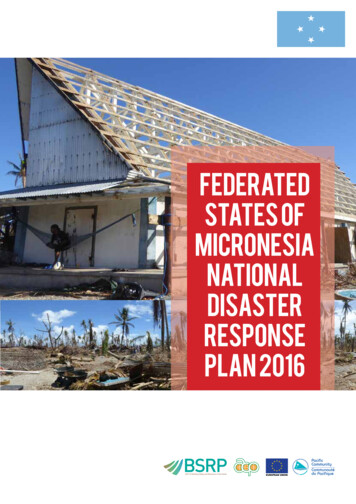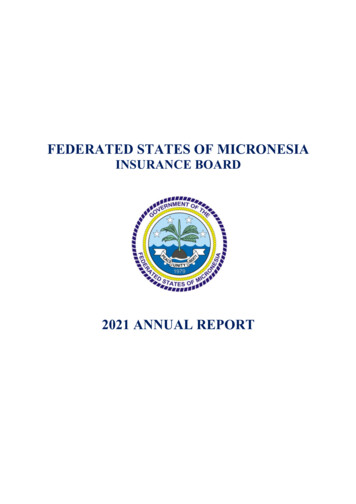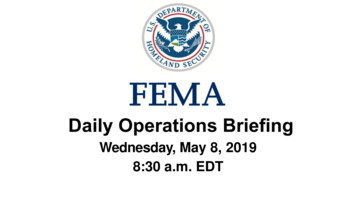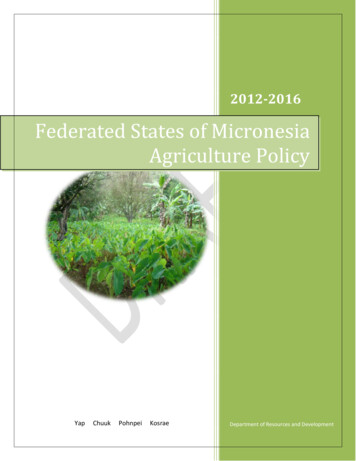
Transcription
2012-2016Federated States of MicronesiaAgriculture PolicyYapChuukPohnpeiKosraeDepartment of Resources and Development
Federated States of Micronesia Agriculture PolicyFEDERATED STATES OF MICRONESIADepartment of Resources and DevelopmentAgriculture Policy2012 - 2016YapChuukPohnpei[2]Kosrae
Federated States of Micronesia Agriculture ds oceans poles/micronesia pol99.jpg)[3]
Federated States of Micronesia Agriculture PolicyFOREWORDSecretary,Resources and Development[4]
Federated States of Micronesia Agriculture PolicyTABLE OF CONTENTSForeword. 4Acronyms and Abbreviations . 6Executive Summary. 7Introduction . 9The Agriculture Sector Context . 10Stakeholders and their Roles in the Agriculture Sector . 12Key Issues, Constraints and Opportunities for Agriculture Development . 13Policy Goals, Development Outcomes and Strategies . 191. A well resourced and properly focused agriculture sector operating within a stable andconsistent policy framework. 202.Enhanced capacity of sector stakeholders . 213. Increased sustainable production (and productivity) of traditional farming systems toprovide for household nutrition, traditional needs and cash incomes. . 224. Increased volumes of saleable agricultural products to be marketed by the private sectorinto domestic and export markets . 235.More product value adding through efficient value chains . 266.Strengthened domestic and international transport linkages . 277.Enhanced synergies between the agriculture and tourism sectors . 278. Enhanced environmental services and sector resilience to natural disasters and climatechange . 28Institutional Framework for Policy Implementation . 29the Implementation and Finacing of the Agriculture Policy . 33Monitoring and Evaluation . 34Annexes . 36Annex 1: Situation Analysis . 36Annex 2: References . 50Annex 3: Institutional organograms . 51Annex4: Policy Stategic Action Matrix . 57[5]
Federated States of Micronesia Agriculture PolicyACRONYMS AND culture Policy Working TeamCoconut Development AuthorityCooperative Extension ServicesCollege of MicronesiaCooperative Research and ExtensionCompact Trust FundFederated States of MicronesiaGross Domestic ProductHousehold Income and Expenditure SurveyJoint Economic Management Committee (US Compact-Department ofInterior)Monitoring and EvaluationMemorandum of UnderstandingMedium Term Expenditure FrameworkNon Government OrganizationNational Trade Facilitation CommitteePacific Island Small Business Centre Development NetworkSmall Business Development CentreOffice of Statistics, Budget and Economic Management, OverseasDevelopment Assistance, and Compact ManagementFederated States of Micronesia’s Strategic Development Plan 2004 -2023Sustainable Land ManagementSmall and Medium Sized EnterprisesSanitary and Phytosanitary StandardsUS Department of Agriculture[6]
Federated States of Micronesia Agriculture PolicyEXECUTIVE SUMMARYThe FSM agriculture sector1 has been identified as one of the priority areas for economic development,however, the sector has not been productive and growth has been sluggish and stagnant over the last20 years. Lack of a coherent policy, legal and regularity framework has inhibited strategic action anddissipated the already limited human and financial resources. The FSM Strategic Development Plan(2004-2023) calls for an agreed vision and adherence to a national agriculture policy framework. ThisAgriculture Policy, which is the conclusion of a participatory consultative process among a wide range ofstakeholders across the four states, provides the basis for action by both public and private sectors toinvigorate sustainable agriculture growth in the Federated States of Micronesia. It recognizes the majorrole played by traditional farming systems and the impact of socio-cultural realities.The agriculture sector provides food, livelihoods and employment for a significant proportion of thepopulation. This policy aims to reflect and address the differentiated needs, constraints andopportunities of small farm families who farm primarily for subsistence and more commercial orientedfarmers and agri-business operators.The nation faces many challenges in achieving national food security and ensuring sustainablelivelihoods for a growing population. FSM economy has contracted in five out of the last seven years,with real GDP falling by 3.6% in 2007 and the weak economy in recent years is reflected in a decline inliving standards and in emigration. The trade account of the balance of payments runs a significantdeficit reflecting the excess of imports over exports. The economy is still firmly dependent on US aid andCompact funding provides about 65% of revenues for national Government and 75% of revenues for thestates, and is the major component of balance of payments. Achieving sustainable growth will dependon reforms that support private sector development and increased foreign investment. Export earnings,among other things need to be increased and in particular tourism, fisheries and agriculture have beenidentified to have development potential. Rising food imports also indicate some opportunities exist forimport substitution by locally grown productsTotal food imports have shown a steep increase from around US 17 million in 2000 to US 43.6 millionin 2009. Convenience starch foods including rice, ramen, noodles, flour and bread have been the majorfood items imported and this group has shown a steep rise over the last 10 years reflecting a change indiets away from traditional staples. The soaring global prices for food and oil mean the costs of importswill continue to rise. Food expenditures now dominate household expenditures, particularly for poorerfamilies, with up to half of total household expenditures on food. Nationally, around 70% of householdshave income below US 15,000 and these households incur annual dis-savings resulting in increasedhardship. Agricultural production for food security and livelihoods remains crucially important and mustbe addressed by a socio-culturally sensitive community-based approach which addresses the differentpriority needs across the four States.1The agriculture sector covers subsistence agriculture, commercial farming, agri-business enterprises, agriindustries, food processing, livestock, quarantine, bio-security and plant protection.[7]
Federated States of Micronesia Agriculture PolicyLocal production needs to remain the core of the food system and the capacity of FSM farmers to tradetheir produce locally, regionally and internationally needs to be supported and extended. TheAgriculture Policy renews the emphasis on domestic food production in the Federated States ofMicronesia with a priority policy focus to national food security and nutritional health through increasedfood self-sufficiency. It addresses the key challenge of developing pathways for commercialization ofsmallholder farming systems building on traditional systems and practices, which allow increasedemployment and cash-generating opportunities for rural households, but without sacrificing family andcommunity cohesion and ultimately food security. An express goal of the policy is that throughinvigorating traditional agriculture to strengthen socio-cultural safety nets.The natural environment is central to food security, livelihoods and the commodity export industries ofFSM. Therefore, sustained growth in the agriculture sector is critically dependent on the sustainablemanagement of the natural resource base. The competing demands on the environment anddifferentiated impacts of climate change will be assessed and taken into consideration when formulatingstrategies to address the development challenges the agriculture sector faces. Sustainable agriculturewill bring benefits to farmers (through improved incomes), and to consumers (through healthier foodchoices) and to ecosystems (by increasing resilience).To achieve the agriculture sector policy goals government will focus on maintaining a sound andconsistent policy and legal framework and ensuring the delivery of services to remove productionconstraints for the private sector, such as providing information on markets, increasing know-how, andproviding effective business development support and essential infrastructure. The Public Sector mainroles will be to invest in core public goods such as data and information, quarantine services, agricultureresearch, basic extension, infrastructure (e.g. rural roads) and enforcement of property rights, rules andcontracts. Although outsourcing in some of these areas and partnering with the private sector and civilsociety may form part of the implementing agenda. To deliver the anticipated development outcomes inthe agricultural sector, institutional reforms (including strengthening the legal and regulatoryframework) and better coordination will also be necessary. However, the important roles thattraditional institutions and governance systems can play in achieving the sector outcomes areacknowledged and this policy promotes consensus building approaches to achieve common goals ratherthan over stressing the role of formal institutions.This overarching agriculture policy framework will be the means for coordination of investments fromnational and state budget revenue together with all other sources of public funds for the sectordevelopment (including, but not limited to, US Compact Funds and Federal Programs and Grants, otherdevelopment partner funds and technical assistance). The government will also use this framework tofacilitate and guide private investments in the sector.[8]
Federated States of Micronesia Agriculture PolicyINTRODUCTIONThe Agriculture Policy, which is the conclusion of a participatory consultative process among a widerange of stakeholders, provides the basis for action by both public and private sectors to invigoratesustainable agriculture growth in the Federated States of Micronesia. The Policy signals desired sectorpriority development outcomes and strategies to achieve these. Successful implementation of this policyshould lead to the realization of a shared vision for the agriculture sector across the four states, Chuuk,Kosrae, Pohnpei and Yap.AGRICULTURE SECTOR VISIONBy 2023, FSM will have a vibrant, robust and productive agriculture sector thatsustainably supports food security, healthy lifestyles, strong social safety nets, andpromotes a greener economy. The sector will provide good employment andincome generation opportunities, economic growth and a decreased trade deficit.This will help ensure a happy, healthy, prosperous and peaceful nation.The Agriculture Policy is premised on seven guiding principles to be adhered to which are consideredessential to sustain the resources base, protect cultural values and promote equitable social andeconomic development. These principles are:Environmental SustainabilityCultural Sensitivity and IntegritySocial and Gender EquityPrivate Sector Led GrowthSubsidiarity2Good Governance and TransparencyObservance of International TreatiesWhile the Agriculture Policy provides an overarching framework for sector development some elementsare purposely generalized to allow for variation according to specific needs and priorities of each state.Stakeholders, during formulation, have indicated broad agreement on the vision statement, guidingprinciples, policy goals and development outcomes. However, it is anticipated that the national andstate governments will refine strategic actions and investments as deemed necessary in the context of2Subsidiarity is an organizing principle that matters ought to be handled by the smallest, lowest or leastcentralized competent authority. The Oxford English Dictionary defines subsidiarity as the idea that a centralauthority should have a subsidiary function, performing only those tasks which cannot be performed effectively ata more immediate or local level.[9]
Federated States of Micronesia Agriculture Policyspecific needs. Some state governments have recently endorsed agriculture strategic action plans whichhave helped guide the formulation of this policy.The need for an agriculture sector policy that reflects the priorities of all stakeholders was identified inthe nation’s Strategic Development Plan (2004-2023) to provide a consistent and agreed vision, toclearly define government’s role in the sector and to strengthen the link between policy andinvestments (from budget allocation and partner support).Unlike social sectors (e.g. education and health), the majority of outputs of the agriculture sector;production, processing and marketing are delivered by private entities be they farm households, farmerco-operatives or larger commercial operations. Therefore the most important government roles insupporting the agriculture sector outcomes do not necessarily relate to public expenditure directly inthe sector, but rather to policy and regularity issues and settings. These include, amongst others, macroeconomic policy, pricing policy (taxes and subsidies), land policy, trade policy, factor prices, and sanitaryand phytosanitary standards (SPS). But reviving growth in agriculture based largely on smallholderproduction will involve considerably more than establishing a benign policy framework. Vitally importantareas of expenditure for supporting growth in the sector would be necessary in infrastructure (ruralroads, bridges, wharfs, ports, market-house and post harvest/storage and quarantine treatmentfacilities), and in improved transport, communications and education. Finally, the close nexus betweenagriculture and the natural environment means that future sustainable development in FSM will bedependent on ensuring an environmentally-friendly agriculture sector.Clearly these important areas of influence for creating the “enabling environment” for private sector ledsustainable agriculture development lie largely outside the remit of the national and state governmentinstitutions directly responsible for agriculture. Thus agriculture policy formation must ensure goodcommunication between a diverse group of stakeholders to build consensus on policy actions andinvestments. This will require an increased policy focus on coordination between sectors and onenhanced links between institutions and actors at the local, state, national and international levels inorder to ensure policy coherence. A lead role in this coordination will be taken by the nationalgovernment institution responsible for agriculture, the FSM Department of Resources and Developmentand through the National Trade Facilitation Committee.THE AGRICULTURE SECTOR CONTEXTWHY AGRICULTURE IS IMPORTANTAgriculture contributes significantly to the livelihoods and food security of a large proportion of FSM’spopulation and is identified in the SDP, along with fisheries and tourism, as a key productive sector forsustainable economic growth.Whilst commercial agriculture remains relatively under developed, agricultural subsistence activitiesbased on localized small scale family farm production are estimated to still make a substantial[10]
Federated States of Micronesia Agriculture Policycontribution to GDP3. Food grown in home-gardens and family farms is primarily for local consumption,but also supports small export sales in regional markets, mainly Guam, the Republic of Marshall Islandsand Saipan.The two principal export crops over the last decade have been betel nut and kava, and these crops alsohave a large and growing domestic market. Relatively small quantities of root crops (including cookedproducts), banana, pepper leaves, peppercorns and citrus are also exported intermittently. Copra was aformer ubiquitous cash crop throughout the FSM, but production has now ceased almost completelydue to inefficiency, volatile commodity prices, and poor transportation linkages coupled with increasingsenility of the coconut palms. Farmstead livestock production (pigs and poultry) is important throughoutFSM, particularly for subsistence and cultural use.Role of the FSMagriculture sectorImproveBalance nitiesfor womenand youthNutritionalhealthExportsEmploymentFood SafetyStrengthenSocialsafety netsFoodSecurityCommunalsharing &exchangeSustainableProductionIncomeFood, skillsTraditionalknowledge &practicesProvideEnvironmentalservicesSource ofbiodiversityRecreationAmenityPrestigeClean water& airMedicinalplants craftmaterialsAgriculture in the FSM can be viewed as more than simply an economic activity as it also provides themeans by which what survives of tradition is largely expressed and maintained, and provides a potentialchannel for individual creativity and enterprise within the traditionally close confines of the extendedfamily and community. Agricultural products including yam, sakau, breadfruit, taro and pigs are crucialfor ceremonial purposes and are important for gifting which helps cement social bonds. It is difficult toassign an economic value to such welfare building, and cultural attributes.It is also well recognized amongst sector stakeholders that agriculture serves a central role in ensuringhealthy lifestyles, providing social safety nets and preserving traditional knowledge, practices and skills.Indeed, food production on family farms together with subsistence and artisanal fishing continue to be avital part of food security and provide resilience in the face of external shocks, either economic (pricespikes, global recession) or natural (cyclones, floods, droughts etc.).3Subsistence estimated overall in 2007 to be 16% of FSM GDP, but varying between states from a high of 28% inChuuk to a low of 11% in Pohnpei.[11]
Federated States of Micronesia Agriculture PolicyFSM traditional agriculture systems are based on biotic diversity and the practice of polyculture ratherthan monoculture and have sustainably provided for subsistence livelihoods, community obligations andfood security over generations. Properly managed these home garden/agroforestry systems can behighly productive whilst also underwriting important environmental services such as soil stabilization,carbon sequestration, clean water and air.But lagging growth in the FSM economy coupled with minimal exports, a significant imbalance of tradeand growing unemployment, especially amongst youth, now justifies a well considered approach leadingto increased productivity and greater commercialization4 of smallholder farms, whilst ensuring that thebenefits of the traditional systems are sustained. This can better be assured with clear recognition andappreciation of the potential tradeoffs between increased commercialization relative to the importantrole and value of existing practices5.Vitalization of the agriculture sector (including a strengthened local food production and marketingsystem) is considered an important medium term policy option for FSM. In this period of globaleconomic uncertainty, the nation should anticipate and prepare for a world where food and oil importswill cost far more than they have in the past; investing now in food production will pay future dividendsfor all our citizens.The Agriculture Policy renews the emphasis on domestic food production in the Federated States ofMicronesia with a priority policy focus to national food security and nutritional health through increasedfood self-sufficiency. It addresses the key challenge of developing pathways for commercialization ofsmallholder farming systems building on traditional systems and practices, which allow increasedemployment and cash-generating opportunities for rural households, but without sacrificing family andcommunity cohesion and ultimately food security.STAKEHOLDERS AND THEIR ROLES IN THE AGRICULTURE SECTORThere are many stakeholders to the FSM agriculture sector. The main stakeholders identified are shownin Table 1 and have been grouped according to their roles as sector output generators; serviceproviders; policy brokers; equity brokers; consumers; and investors.This policy promotes private sector-led agriculture growth and recognizes that the private sector including farmers (big and small), traders, food vendors, processors and exporters – are the major sectoroutput generators. The private sector also provides important services to the sector and it is envisagedthat private sector operators, where appropriate, will increasingly be involved in service roles. Privatesector organizations (e.g. Chamber of Commerce, Farmers Associations) are currently strengtheningtheir role as equity brokers to provide a voice in policy formulation and ensure equitable outcomes fortheir members. It is anticipated that consumer demand for higher product quality and standards willalso increasingly impact on sector policy.4Commercialization is broadly visualized as the orientation to market-led production, processing and efficientsupply chain management.5Refer to WM Drew, 2008.[12]
Federated States of Micronesia Agriculture PolicyTable 1: FSM Agriculture Sector StakeholdersSECTOR OUTPUTGENERATORSPrivate SectorSERVICEPROVIDERSPublic , Private,NGOPOLICY BROKERSEQUITY BROKERSCONSUMERSINVESTORSPublic, PrivateFarmers (small & bigwomen & men)ResearchersCOM-FSMCongress, SenateWomen’srepresentativesRural HouseholdsUrban ConsumersGovernmentTraders local foodvendorsExtension AgentsCOM-FSMState LegislatureTraditional ChiefsTouristsUS COMPACT , USDAOther DevelopmentPartnersProcessorsFinanciers, businessservice & creditprovidersMunicipal Gov.Chamber CommerceOverseas ConsumersNational and ForeignBusiness InvestorsExportersEducators/trainersTraditional ChiefsOther NGO’s?Environmental NGO?Farmers AssociationFarmers CooperativesInput suppliersFarmers AssociationsJEMCOFarmers AssociationDepartmentAgricultureCDATransporters (trucks,boats, ships, planes,stevedores)Finance (SBOC)Church representativesNGOs?Utility Providers(power, water)TradeMunicipal GovState LegislatureInfrastructureprovidersCustoms & RevenueAgriculture DeptEnvironment NGOsRegulatory(quarantine, foodstandards)The Public Sector main roles will be to invest in core public goods such as data and information,quarantine services, agriculture research, basic extension, infrastructure (e.g. rural roads) andenforcement of property rights, rules and contracts. Although outsourcing in some of these areas andpartnering with the private sector and civil society may form part of the implementing agenda. Wheregovernment does find it necessary to intervene because of market failure to provide adequate services,it will attempt to do this in the least distorting manner, with the aim of fostering equitable growth andwith implementation through a constructive dialogue with the private sector. Any government supportin the market will be for time-bound interventions that aim to stimulate an effective private sectorresponse. Where government currently undertakes a role as an output generator this role will bereviewed with the aim to transition responsibility to the private sector.Government will continue to strengthen its key roles in facilitation, coordination and regulation tocreate an enabling environment for the private sector to operate.KEY ISSUES, CONSTRAINTS AND OPPORTUNITIES FOR AGRICULTURE DEVELOPMENTSTAGNANT ECONOMIC AND PRIVATE SECTOR DEVELOPMENTStagnant economic activity, limited employment opportunities and an increasing incidence of povertyare the priority development issues government faces. The agriculture sector provides a solid basis forfood security, but also offers significant (as yet under-exploited) opportunities for gainful employmentand income generation. Farming as a business needs to be more fully developed.WEAK LEADERSHIP AND COORDINATION IN THE SECTORComplex political and institutional structures, bureaucratic channels for communication and limitedhuman resource capacity have combined to inhibit leadership and coordination in the agriculture sector.[13]
Federated States of Micronesia Agriculture PolicyWithout strong leadership and good coordination investments are ad hoc and poorly oriented to sectorpriorities. Lack of a coherent policy, legal and regularity framework has inhibited strategic action anddissipated the already limited human and financial resources.EVIDENCE BASED DECISION MAKINGAccessing reliable data is a significant issue and poses a serious challenge to monitoring the agriculturesector performance and the effectiveness of policy and investments. Lack of data constrains efficientplanning and budgeting for the sector. Without good sector data it is difficult to assess developmentoutcomes and draw lessons.Subsistence activity is still considered to be very significant, but there is lack of data and poorunderstanding in this area. Without specific-information on amounts of food available and the potentialto produce more a solid statement on food security and vulnerability is difficult.In the absence of an agriculture census basic structural information on the sector is not available toprovide baseline data on the production and economic value and use of existing agricultural systems.Equally without regular surveys and reliable administrative data sources monitoring production trendsand trade in agriculture commodities is severely constrained.BUDGETARY ALLOCATION.Insufficient budgetary allocation to the agricultural sector continues to be a key constraint which hasreduced human resources and service delivery by government institutions. The SDP envisaged that thebudget share allocated to agriculture would increase to 3% of total by 2009, but in fact budget allocationat state level has been stagnant or in some cases declining. Government support activities increasinglydepend on ad hoc project funds which threatens the sustainability of service provision. The AgricultureSector needs a level of funding that recognizes its status as a “priority productive sector” and a majorsource of employment. However, with continuing fiscal constraint and need to keep a balanced budgetprospects for increases in budget allocation for agriculture are not good. It will therefore be critical thatavailable funds (including those from development partners) are well coordinated and targeted toprioritized policy actions and service provision is streamlined and efficient.VULNERABILITY TO GLOBAL FOOD AND COMMODITY PRICESThe nation is highly vulnerable to global food and commodity prices as a net food importer with anincreasing reliance on food imports. Because of our isolated location and geographical formation (manydispersed islands) fuel prices are also a very critical issue.LARGE TRADE DEFICITA large and increasing trade deficit without significant merchandise or services exports increasesvulnerability to global commodity prices and undermines macroeconomic stability. The agriculturesector provides opportunities to increase export of goods, but currently trade in agricultural products isminimal. There is also some opportunity for local fresh and processed produce to substitute for[14]
Federated States of Micronesia Agriculture Policyimported goods and thus to reduce risks associated with any restrictions of imports should there be anybalance of payments problems in the future.INCREASING INCIDENCE OF DIET AND LIFESTYLE RELATED NON COMMUNICABLE DISEASES.Serious problems of nutritionally-related diseases occur in FSM, including vitamin A deficiency andanemia among children, diabetes, heart disease, and certain cancers among adults. These nutritionproblems
providing effective business development support and essential infrastructure. The Public Sector main roles will be to invest in core public goods such as data and information, quarantine services, agriculture research, basic extension, infrastructure (e.g. rural roads) and enforcement of property rights, rules and contracts.

